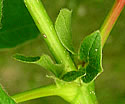Acer nigrum (Black Maple)
| Also known as: | |
|---|---|
| Genus: | Acer |
| Family: | Sapindaceae (Soapberry) |
| Life cycle: | perennial woody |
| Origin: | native |
| Habitat: | part shade, shade, sun; mesic forest, floodplain margins |
| Bloom season: | April - June |
| Plant height: | 60 to 100 feet |
| Wetland Indicator Status: | GP: none MW: FACU NCNE: FACU |
| MN county distribution (click map to enlarge): |  |
| National distribution (click map to enlarge): |  |
Pick an image for a larger view. See the glossary for icon descriptions.
Detailed Information
Flower: 
Drooping clusters at branch tips appearing about the same time as when leaves emerge. Male and female flowers are long stalked, greenish yellow, borne on separate branches of the same tree, sometimes on separate trees or on the same branch. Occasionally flowers are perfect (contain both male and female parts). The flower stalks are hairy, the calyx five lobed and without petals, the male stamens extended just beyond the calyx, the females with two extended stigmas, sometimes several times as long as the calyx.
Leaves and bark: 


![[photo of leaves]](/udata/r9ndp23q/trees/acer-nigrum-black-maple1-t.jpg) Leaves are simple and opposite, the blade up to 6½ inches long and 7¼ inches wide with 3 to 5 palmate lobes, the two basal lobes much reduced with only rounded tips or sometimes lacking altogether. The leaf stalk is about the same length as the blade, smooth to short-hairy, and typically has conspicuous, hairy stipules (leafy appendages) at the base.
Leaves are simple and opposite, the blade up to 6½ inches long and 7¼ inches wide with 3 to 5 palmate lobes, the two basal lobes much reduced with only rounded tips or sometimes lacking altogether. The leaf stalk is about the same length as the blade, smooth to short-hairy, and typically has conspicuous, hairy stipules (leafy appendages) at the base.
![[photo of leaf hairs]](/udata/r9ndp23q/pd3/acer-nigrum-7098-t.jpg) Upper surface is dark green and hairless, the lower surface paler with fine, erect hairs, more densely along major veins which gives it a soft, velvety feel. Edges are often drooping and typically have 1 to 6 points on each side.
Upper surface is dark green and hairless, the lower surface paler with fine, erect hairs, more densely along major veins which gives it a soft, velvety feel. Edges are often drooping and typically have 1 to 6 points on each side.
![[photo of bark]](/udata/r9ndp23q/pd3/acer-nigrum-754389-1-t.jpg) One year old twigs are smooth and brown to grayish, older branches and trunk are dark gray with short, corky ridges. The trunk can grow to 48 inches in diameter at breast height (dbh).
One year old twigs are smooth and brown to grayish, older branches and trunk are dark gray with short, corky ridges. The trunk can grow to 48 inches in diameter at breast height (dbh).
Fruit: 
Fruit is a pair of winged seeds (samara), that can be up to 1½ inches long but more typically around an inch. Fruit matures from September into October. The wings form between a 45 and 90 degree angle.
Notes:
Black Maple is a large forest tree found only in Minnesota's southeast. It is somewhat cryptic in being very similar to the more widespread Sugar Maple (Acer saccharum) that frequently shares its habitat, and the two do hybridize. There is some discussion whether they should both be treated as varieties of A. saccharum, but the current status in Minnesota is they are distinct species. Black Maple is more tolerant to some sedimentation and can grow in floodplains that experience minimal flooding, where Sugar Maple will be found only in upland mesic forest. Leaf characteristics for the two are rather variable and there is much overlap so are not always reliable, but Black maple leaves typically have 6 or fewer points per side, where Sugar Maple usually has 5 to 11. The leaf margins of Black are consistently drooping, especially when young, but Sugar may display this as well. Black, however, has stipules at the base of the leaf stalk and, while not present or of great size on every leaf, invariably these can be located throughout the branches. Sugar does not have these stipules. Also, Black is fairly consistently hairy across the lower surface of the leaf giving the leaf a soft velvety texture. Sugar is usually only hairy along the main veins or just in the vein axils, but when present on the surface, the hairs are typically sparse and appressed giving the leaf a soft silky texture.
Native Plant Nurseries, Restoration and Landscaping Services ↓
More photos
 Black Maple in a rural farmyard
Black Maple in a rural farmyard droopy leaves
droopy leaves fall color
fall color lichen covered trunk
lichen covered trunk distinguishing stipules
distinguishing stipules
Photos courtesy Peter M. Dziuk taken in Fillmore and Winona counties.
Comments
Have you seen this plant in Minnesota, or have any other comments about it?
on: 2021-09-07 16:23:35
I am so happy to have identified a beloved tree on our property after years of wondering. My Google searches were always fruitless as I could never seem to find an exact leaf match. I don't know if my tree would be a hybrid of the two or a straight-up Black Maple, but I can tell you I've been bouncing around in excitement since getting some help with ID via a Facebook group. It is a very special tree, absolutely massive and perfect for our family. I want 100 more and will be utterly devastated when we have to take it down. (I've been told it is rotting on the inside from the previous owners but have not had it analyzed. Do I have to go with a private business or does the state/county offer consultations? :)
on: 2021-09-07 18:13:03
Amanda, Master Gardeners might advise you.






